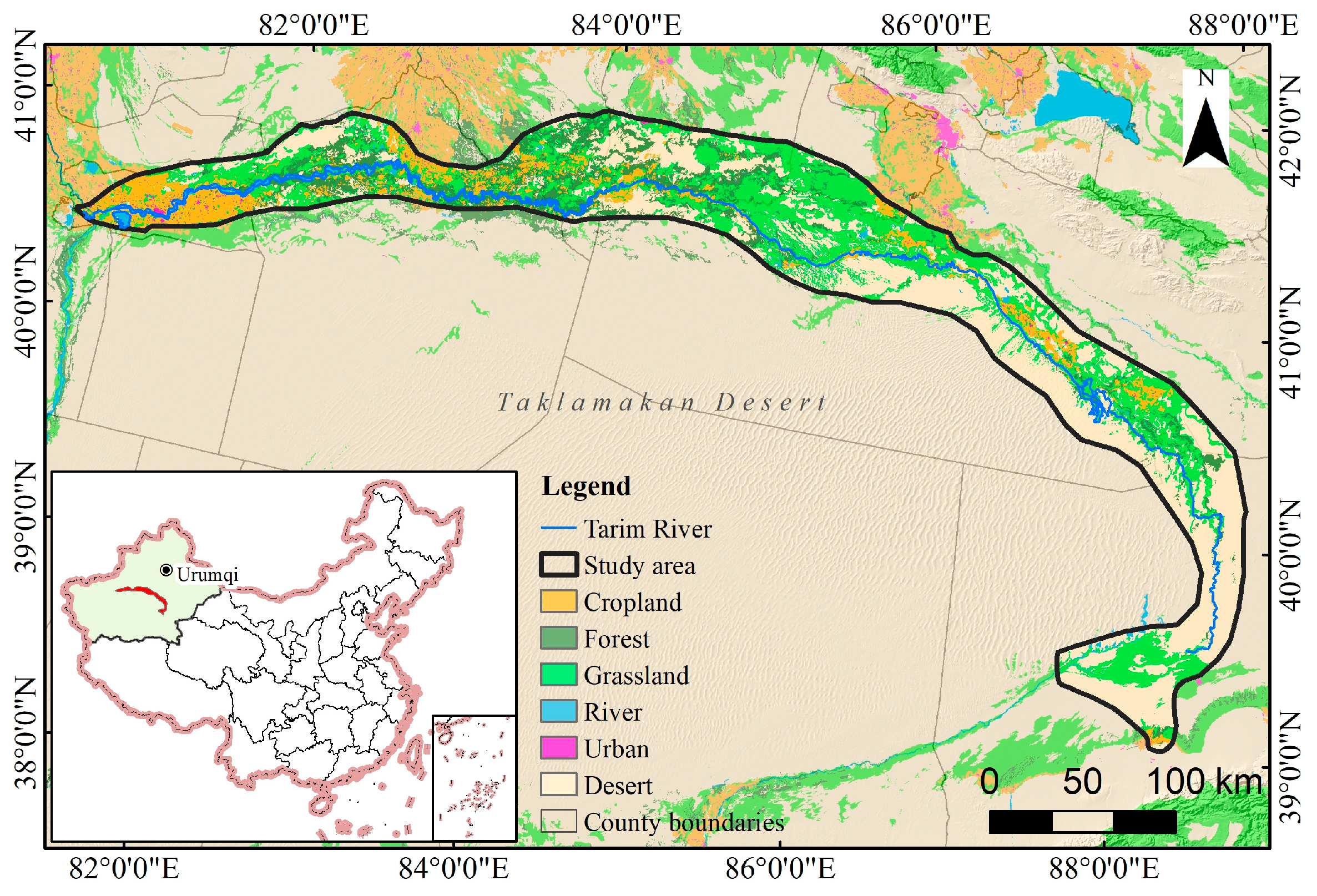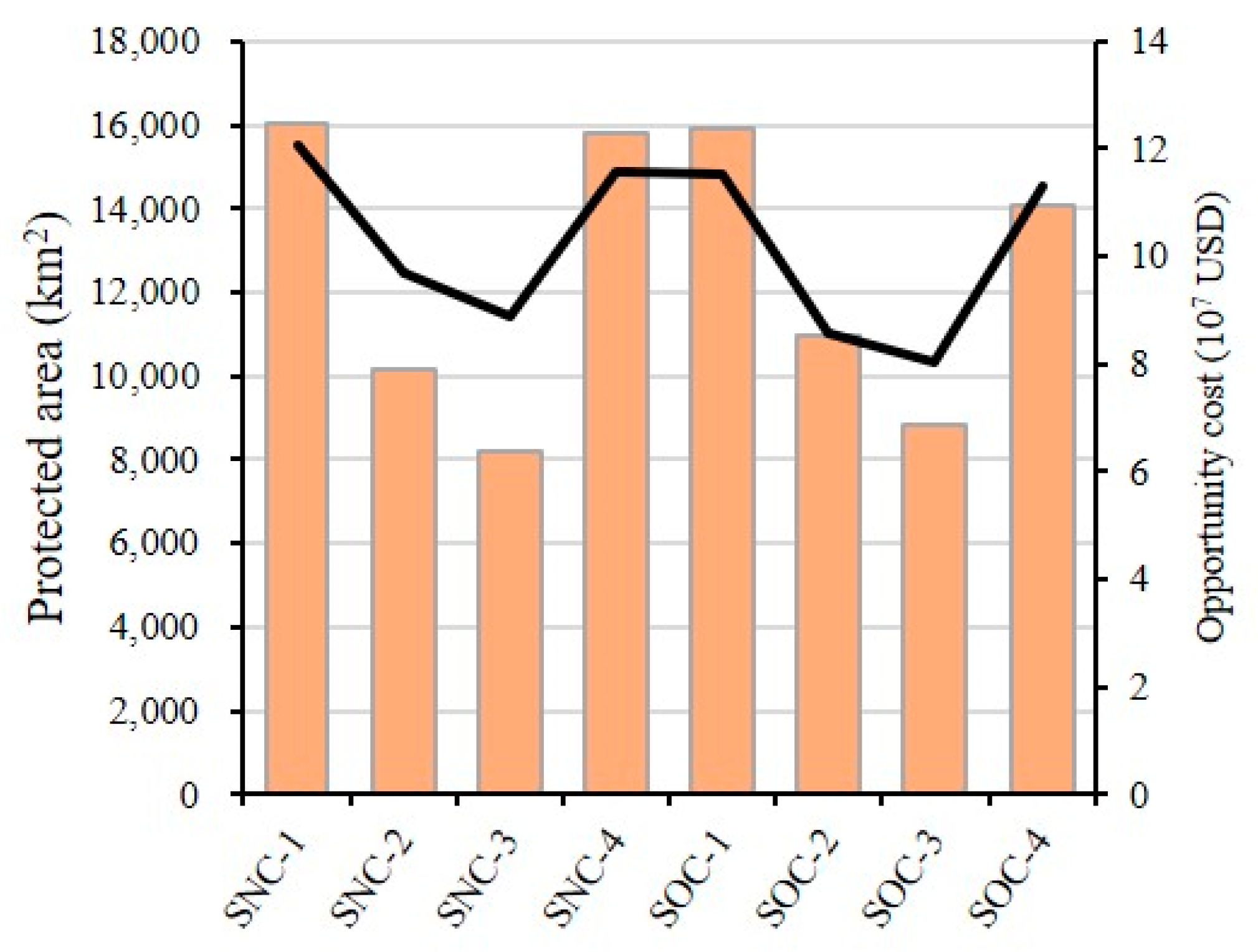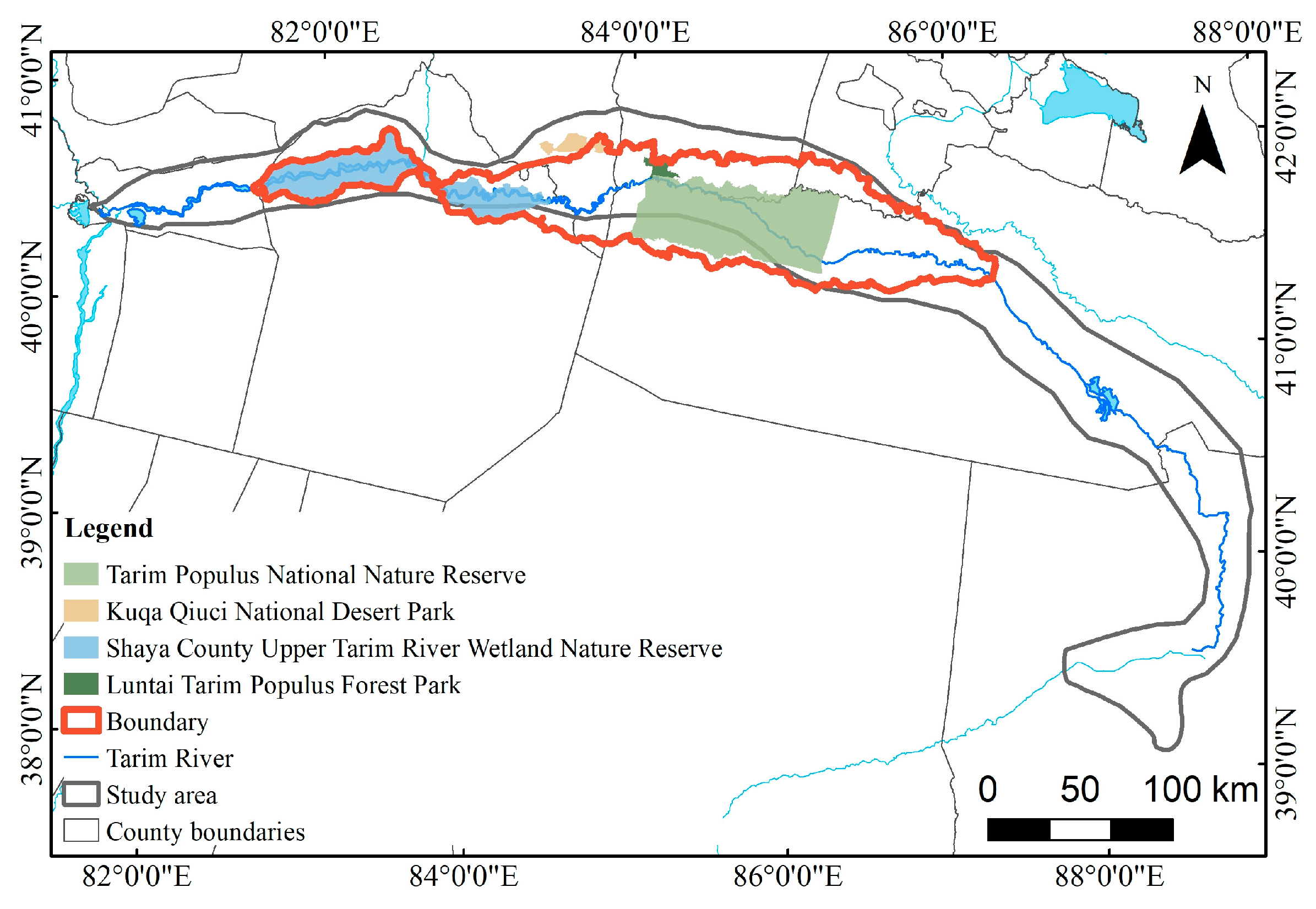Spatial Optimization Based on the Trade-Off between Ecosystem Conservation and Opportunity Cost of Tarim National Park in Xinjiang, China
Abstract
:1. Introduction
2. Materials and Methods
2.1. Study Area
2.2. Screening for Conservation of Important Species and Habitat Modeling
2.3. Selection of Ecological Importance Indicators
2.4. Boundary Identification and Spatial Optimization
2.4.1. Opportunity Cost Calculation
2.4.2. Scenario Settings and Spatial Optimization Algorithms
3. Results
3.1. Simulating Species Habitat and Assessing Ecological Indicators
3.2. Optimization of Protection Scenarios
3.3. Choosing the Optimal Protection Option and Establishing the Boundary
4. Discussion
5. Conclusions
Supplementary Materials
Author Contributions
Funding
Data Availability Statement
Acknowledgments
Conflicts of Interest
References
- Wu, R.; Hua, C.; Yu, G.; Ma, J.; Yang, F.; Wang, J.; Jin, T.; Long, Y.; Guo, Y.; Zhao, H. Assessing protected area overlaps and performance to attain China’s new national park system. Biol. Conserv. 2020, 241, 108382. [Google Scholar] [CrossRef]
- Du, A.; Cui, T.; Song, T.Y.; Ouyang, Z.Y. International experiences of national park selection criteria and the inspiration to China. Acta Ecol. Sin. 2020, 40, 7231–7237. (In Chinese) [Google Scholar] [CrossRef]
- Zang, Z.H.; Zhang, D.; Wang, N.; Du, A.; Kong, L.Q.; Xu, W.H.; Ouyang, Z.Y. Experiences, achievement, problems and recommendations of the first batch of China’s national park system pilots. Acta Ecol. Sin. 2020, 40, 8839–8850. (In Chinese) [Google Scholar] [CrossRef]
- Xu, W.; Pimm, S.L.; Du, A.; Su, Y.; Fan, X.; An, L.; Liu, J.; Ouyang, Z. Transforming protected area management in China. Trends Ecol. Evol. 2019, 34, 762–766. [Google Scholar] [CrossRef]
- Lewis, E.; MacSharry, B.; Juffe-Bignoli, D.; Harris, N.; Burrows, G.; Kingston, N.; Burgess, N.D. Dynamics in the global protected-area estate since 2004. Conserv. Biol. 2019, 33, 570–579. [Google Scholar] [CrossRef] [PubMed]
- Yu, H.; Zhong, L.S. Discussion on the selection criteria of national parks in China based on international experience. Acta Ecol. Sin. 2019, 39, 1309–1317. (In Chinese) [Google Scholar] [CrossRef]
- GB/T 39737-2021; Specification for National Park Establishment. National Forestry and Grassland Administration: Beijing, China, 2021. Available online: https://openstd.samr.gov.cn/bzgk/gb/newGbInfo?hcno=7F9CF60018CF8E6EB8A441C7434337C4 (accessed on 21 May 2022). (In Chinese)
- Tang, X.P.; Ouyang, Z.Y.; Jiang, Y.F.; Ma, W.; Xu, W.H.; Chen, S.; Liu, Z.L. Spatial planning of national parks in China. Natl. Park. 2023, 1, 1–10. (In Chinese) [Google Scholar]
- Margules, C.R.; Pressey, R.L.; Williams, P.H. Representing biodiversity: Data and procedures for identifying priority areas for conservation. J. Biosci. 2002, 27, 309–326. [Google Scholar] [CrossRef]
- Peng, Y.; Yang, R.; Cao, Y.; Wang, F.; Hou, S.; Tseng, T.; Wang, X.; Wang, P.; Zhao, Z.; Yu, L.; et al. One-third of lands face high conflict risk between biodiversity conservation and human activities in China. J. Environ. Manag. 2021, 299, 113449. [Google Scholar] [CrossRef]
- Xue, S.; Fang, Z.; Bai, Y.; Alatalo, J.M.; Yang, Y.; Zhang, F. The next step for China’s national park management: Integrating ecosystem services into space boundary delimitation. J. Environ. Manag. 2023, 329, 117086. [Google Scholar] [CrossRef]
- Rohwer, Y.; Marris, E. Ecosystem integrity is neither real nor valuable. Conserv. Sci. Pract. 2021, 3, e411. [Google Scholar] [CrossRef]
- Zhang, J.; Jiang, F.; Li, G.; Qin, W.; Li, S.; Gao, H.; Cai, Z.; Lin, G.; Zhang, T. Maxent modeling for predicting the spatial distribution of three raptors in the Sanjiangyuan National Park, China. Ecol. Evol. 2019, 9, 6643–6654. [Google Scholar] [CrossRef] [PubMed]
- Natsukawa, H.; Yuasa, H.; Sutton, L.J.; Amano, H.; Haga, M.; Itaya, H.; Kawashima, H.; Komuro, S.; Konno, T.; Mori, K.; et al. Utilizing a top predator to prioritize site protection for biodiversity conservation. J. Environ. Manag. 2023, 347, 119110. [Google Scholar] [CrossRef]
- National Parks Spatial Layout Program Issued. Available online: https://www.forestry.gov.cn/c/www/ze/29773.jhtml (accessed on 30 May 2023). (In Chinese)
- Zhong, L.; Zhao, Z.C.; Tang, J.L. Nature Education Planning Conception and Framework of China’s National Parks. Chin. Landsc. Archit. 2022, 38, 116–120. (In Chinese) [Google Scholar]
- Chen, Y.N.; Chen, Y.P.; Li, W.H.; Zhang, H.F. Response of the accumulation of proline in the bodies of Populus euphratica to the change of groundwater level at the lower reaches of Tarim River. Chin. Sci. Bull. 2003, 48, 1995–1999. [Google Scholar] [CrossRef]
- Hou, L.G.; Xiao, H.L.; Si, J.H.; Xiao, S.C.; Zhou, M.X.; Yang, Y.G. Evapotranspiration and crop coefficient of Populus euphratica Oliv forest during the growing season in the extreme arid region northwest China. Agric. Water Manag. 2010, 97, 351–356. [Google Scholar] [CrossRef]
- Ling, H.; Guo, B.; Zhang, G.; Xu, H.; Deng, X. Evaluation of the ecological protective effect of the “large basin” comprehensive management system in the Tarim River basin, China. Sci. Total Environ. 2019, 650, 1696–1706. [Google Scholar] [CrossRef]
- Zhu, C.G.; Aikeremu, A.; Li, W.H.; Zhou, H.H. Ecosystem restoration of Populus euphratica forest under the ecological water conveyance in the lower reaches of Tarim River. Arid. Land Geogr. 2021, 44, 629–636. (In Chinese) [Google Scholar] [CrossRef]
- Zhang, P.; Deng, X.; Long, A.; Xu, H.; Ye, M.; Li, J. Change in Spatial Distribution Patterns and Regeneration of Populus euphratica under Different Surface Soil Salinity Conditions. Sci. Rep. 2019, 9, 9123. [Google Scholar] [CrossRef]
- Tuohetahong, Y. Effects of Climate Change on the Distribution of Six Species Important Wild Animals and Plants in Tarim Basin and Its Adaptive Countermeasures. Master’s Thesis, Xinjiang University, Urumqi, China, 2020. (In Chinese). [Google Scholar]
- Guo, F.L.; Xu, G.B.; Lu, M.Z.; Meng, Y.H.; Yuan, C.Z.; Guo, K.Q. Prediction of Potential Suitable Distribution Areas for Populus euphratica using the MaxEnt Model. Sci. Silae Sin. 2020, 56, 184–192. (In Chinese) [Google Scholar] [CrossRef]
- The List of National Key Protected Wildlife in China. Available online: https://www.gov.cn/xinwen/2021-02/09/content_5586227.htm (accessed on 1 February 2022).
- The List of State Key Protected Wildlife in Xinjiang, China. Available online: https://www.xinjiang.gov.cn/xinjiang/ (accessed on 29 September 2022).
- Pimm, S.L.; Jenkins, C.N.; Abell, R.; Brooks, T.M.; Gittleman, J.L.; Joppa, L.N.; Raven, P.H.; Roberts, C.M.; Sexton, J.O. The biodiversity of species and their rates of extinction, distribution, and protection. Science 2014, 344, 1246752. [Google Scholar] [CrossRef] [PubMed]
- Phillips, S.J.; Dudík, M. Modeling of Species Distributions with Maxent: New Extensions and a Comprehensive Evaluation. Ecography 2008, 31, 161–175. [Google Scholar] [CrossRef]
- Brown, J.L. SDMtoolbox: A python-based GIS toolkit for landscape genetic, biogeographic and species distribution model analyses. Methods Ecol. Evol. 2014, 5, 694–700. [Google Scholar] [CrossRef]
- Li, Y.; Gao, X.; An, Q.; Sun, Z.; Wang, H. Ecological niche modeling based on ensemble algorithms to predicting current and future potential distribution of African swine fever virus in China. Sci. Rep. 2022, 12, 15614. [Google Scholar] [CrossRef] [PubMed]
- Carroll, C.; Johnson, D.S.; Dunk, J.R.; Zielinski, W.J. Hierarchical Bayesian spatial models for multispecies conservation planning and monitoring. Conserv. Biol. J. Soc. Conserv. Biol. 2010, 24, 1538–1548. [Google Scholar] [CrossRef] [PubMed]
- China Multi-Period Land Use Remote Sensing Monitoring Data Set (CNLUCC). 2018. Available online: https://www.resdc.cn/DOI/DOI.aspx?DOIID=54 (accessed on 21 May 2022). [CrossRef]
- Spatial Distribution of Annual Vegetation Index (NDVI) Dataset in China. 2018. Available online: https://www.resdc.cn/DOI/DOI.aspx?DOIID=49 (accessed on 21 May 2022). [CrossRef]
- Ouyang, Z.; Zheng, H.; Xiao, Y.; Polasky, S.; Liu, J.; Xu, W.; Wang, Q.; Zhang, L.; Xiao, Y.; Rao, E.; et al. Improvements in ecosystem services from investments in natural capital. Science 2016, 352, 1455–1459. [Google Scholar] [CrossRef] [PubMed]
- Zhang, Q.; Zhang, D.F.; Wu, M.L.; Guo, J.; Sun, C.Z.; Xie, C.X. Predicting the global areas for potential distribution of Gastrodia elata based on ecological niche models. Chin. J. Plant Ecol. 2017, 41, 770–778. [Google Scholar] [CrossRef]
- Wang, H.Y.; Zuo, X.; Wang, D.L.; Bi, Y.Y. The estimation of forest residue resources in China. J. Cent. South Univ. For. Technol. 2017, 37, 29–43. (In Chinese) [Google Scholar]
- Yao, Y. The Study on the Market of Internal Conversion of Contracted Managerial Rower of Grassland in Inner Mongolia. Master’s Thesis, Inner Mongolia Agricultural University, Huhhot, China, 2009. (In Chinese). [Google Scholar]
- Waldron, A.; Mooers, A.O.; Miller, D.C.; Nibbelink, N.; Redding, D.; Kuhn, T.S.; Roberts, J.T.; Gittleman, J.L. Targeting global conservation funding to limit immediate biodiversity declines. Proc. Natl. Acad. Sci. USA 2013, 110, 12144–12148. [Google Scholar] [CrossRef]
- Xu, H.; Cao, Y.; Yu, D.; Cao, M.; He, Y.; Gill, M.; Pereira, H.M. Ensuring effective implementation of the post-2020 global biodiversity targets. Nat. Ecol. Evol. 2021, 5, 411–418. [Google Scholar] [CrossRef]
- Pimm, S.L. From aspiration to implementation of the 30% solution. Natl. Sci. Rev. 2023, 10, nwad195. [Google Scholar] [CrossRef] [PubMed]
- Arroyo Rodríguez, V.; Fahrig, L.; Tabarelli, M.; Watling, J.I.; Tischendorf, L.; Benchimol, M.; Cazetta, E.; Faria, D.; Leal, I.R.; Melo, F.P.L.; et al. Designing optimal human-modified landscapes for forest biodiversity conservation. Ecol. Lett. 2020, 23, 1404–1420. [Google Scholar] [CrossRef]
- Dinerstein, E.; Vynne, C.; Sala, E.; Joshi, A.R.; Fernando, S.; Lovejoy, T.E.; Mayorga, J.; Olson, D.; Asner, G.P.; Baillie, J.; et al. A Global Deal for Nature: Guiding principles, milestones, and targets. Sci. Adv. 2019, 5, w2869. [Google Scholar] [CrossRef] [PubMed]
- Evans, J.L.; Peckett, F.; Howell, K.L. Combined application of biophysical habitat mapping and systematic conservation planning to assess efficiency and representativeness of the existing High Seas MPA network in the Northeast Atlantic. Ices J. Mar. Sci. 2015, 72, 1483–1497. [Google Scholar] [CrossRef]
- Zhang, L.; Ouyang, Z.Y.; Xu, W.H. Theory, work frame and hot issues of systematic conservation planning. Acta Ecol. Sin. 2015, 35, 1284–1295. (In Chinese) [Google Scholar] [CrossRef]
- Hou, M.; Tang, X.P.; Huang, G.L.; Li, R.Q. Identification of the priority conservation areas of national park: A case study of Lishui City, Zhejiang Province, China. Chin. J. Appl. Ecol. 2020, 31, 2332–2340. [Google Scholar] [CrossRef]
- Zhao, Z.C.; Yang, R. The concept of national park authenticity and integrity in China and its evaluation framework. Biodivers. Sci. 2021, 29, 1271–1278. [Google Scholar] [CrossRef]
- Xia, M.; Jia, K.; Wang, X.; Bai, X.; Li, C.; Zhao, W.; Hu, X.; Cherubini, F. A framework for regional ecosystem authenticity evaluation–a case study on the Qinghai-Tibet Plateau of China. Glob. Ecol Conserv. 2021, 31, e1849. [Google Scholar] [CrossRef]
- Fabbrizzi, E.; Giakoumi, S.; De Leo, F.; Tamburello, L.; Chiarore, A.; Colletti, A.; Coppola, M.; Munari, M.; Musco, L.; Rindi, F.; et al. The challenge of setting restoration targets for macroalgal forests under climate changes. J. Environ. Manag. 2023, 326, 116834. [Google Scholar] [CrossRef]
- Gatiso, T.T.; Kulik, L.; Bachmann, M.; Bonn, A.; Bösch, L.; Eirdosh, D.; Freytag, A.; Hanisch, S.; Heurich, M.; Sop, T.; et al. Effectiveness of protected areas influenced by socio-economic context. Nat. Sustain. 2022, 5, 861–868. [Google Scholar] [CrossRef]
- Smith, T.; Boers, N. Reliability of vegetation resilience estimates depends on biomass density. Nat. Ecol. Evol. 2023, 7, 1799–1808. [Google Scholar] [CrossRef] [PubMed]
- Roche, P.K.; Campagne, C.S. From ecosystem integrity to ecosystem condition: A continuity of concepts supporting different aspects of ecosystem sustainability. Curr. Opin. Environ. Sustain. 2017, 29, 63–68. [Google Scholar] [CrossRef]
- Zhang, Y.; Li, Y.; Lv, J.; Wang, J.; Wu, Y. Scenario simulation of ecological risk based on land use/cover change–A case study of the Jinghe county, China. Ecol. Indic. 2021, 131, 108176. [Google Scholar] [CrossRef]
- Wang, Y.; Zhao, R.; Zhou, X.; Zhang, X.; Zhao, G.; Zhang, F. Prediction of potential distribution areas and priority protected areas of Agastache rugosa based on Maxent model and Marxan model. Front. Plant Sci. 2023, 14, 1200796. [Google Scholar] [CrossRef] [PubMed]
- Adams, V.M.; Pressey, R.L.; Naidoo, R. Opportunity costs: Who really pays for conservation? Biol. Conserv. 2010, 143, 439–448. [Google Scholar] [CrossRef]
- Sinden, J.A. Estimating the opportunity costs of biodiversity protection in the Brigalow Belt, New South Wales. J. Environ. Manag. 2004, 70, 351–362. [Google Scholar] [CrossRef]
- Rodrigues, A.; Rouyer, M.M. Measuring the ecological benefits of protected areas. Nature 2023, 622, 39–40. [Google Scholar] [CrossRef]







| Indicator | Main Evaluation Indicator | Quantitative Indicator | Definition of Indicator |
|---|---|---|---|
| Representativeness | Ecosystem representation | Percentage of Populus euphratica | Ecosystems that represent regional traits, structure, and function. We used the unit’s Populus euphratica community proportion as a sample calculation. |
| Landscape value | Distribution of natural landscapes or geological sites | Regional natural landscape importance, uniqueness, and aesthetic or cultural value. | |
| Ecological significance | Authenticity | Aboveground biomass density | Ecosystem structure, function, health, and disparity with top communities. |
| Suitable habitat for flagship species | Habitat distribution of key protected species | Expression of regional ecological diversity, distribution of habitats of key species. | |
| Importance of ecological location | Ecosystem services | Reflecting ecosystems’ role in ecological equilibrium, human well-being, and sustainable development. | |
| Susceptibility to threats | Trends in fractional vegetation cover | Indicates the extent to which an environment or species faces external or internal pressures and dangers that could cause its demise. | |
| Feasibility | Feasibility of resource conservation | Existing foundations of the protected area | Clear land tenure and natural property rights are needed to protect and develop national parks. |
| Scenario Number | Protection Rule | Protection Object Selection and Protection Target | |||||
|---|---|---|---|---|---|---|---|
| 11010 | 11004 | 13003 | 21001 | 21003 | 31000 | ||
| SNC-1 | High-priority conservation targets for objects under the same costs | 60% | 50% | 50% | 50% | 50% | 50% |
| SNC-2 | Medium-priority conservation targets for objects under the same costs | 50% | 30% | 30% | 30% | 30% | 30% |
| SNC-3 | Medium-priority conservation targets for important species under the same costs | 40% | 30% | 30% | - | - | - |
| SNC-4 | High-priority conservation target only for Populus euphratica under the same costs | 60% | - | - | - | - | - |
| SOC-1 | High-priority conservation targets for objects under opportunity cost | 60% | 50% | 50% | 50% | 50% | 50% |
| SOC-2 | Medium-priority conservation targets for objects under opportunity cost | 50% | 30% | 30% | 30% | 30% | 30% |
| SOC-3 | Medium-priority conservation targets for important species under opportunity cost | 40% | 30% | 30% | - | - | - |
| SOC-4 | High-priority conservation target only for Populus euphratica under opportunity cost | 60% | - | - | - | - | - |
| Scenario Number | Protection Effects (%) | Protected Area (km2) | Protection Cost (104 USD) | |||||
|---|---|---|---|---|---|---|---|---|
| 11010 | 11004 | 13003 | 21001 | 21003 | 31000 | |||
| SNC-1 | 93.8 | 66.0 | 79.5 | 64.3 | 89.3 | 85.7 | 16,048.08 | 12,064.12 |
| SNC-2 | 46.9 | 30.9 | 27.0 | 23.2 | 32.4 | 55.2 | 10,130.31 | 9703.57 |
| SNC-3 | 35.5 | 24.4 | 23.9 | 16.3 | 28.5 | 32.8 | 8189.82 | 8897.62 |
| SNC-4 | 93.7 | 58.6 | 71.4 | 57.2 | 85.2 | 68.3 | 15,800.29 | 11,580.55 |
| SOC-1 | 92.2 | 65.0 | 76.8 | 82.1 | 80.4 | 70.8 | 15,901.20 | 11,514.18 |
| SOC-2 | 77.3 | 17.6 | 26.4 | 45.3 | 38.7 | 32.7 | 10,949.68 | 8570.46 |
| SOC-3 | 31.9 | 11.7 | 16.7 | 32.4 | 25.6 | 23.1 | 8842.86 | 8035.38 |
| SOC-4 | 95.3 | 34.2 | 42.2 | 52.3 | 88.7 | 73.4 | 14,087.62 | 11,320.33 |
Disclaimer/Publisher’s Note: The statements, opinions and data contained in all publications are solely those of the individual author(s) and contributor(s) and not of MDPI and/or the editor(s). MDPI and/or the editor(s) disclaim responsibility for any injury to people or property resulting from any ideas, methods, instructions or products referred to in the content. |
© 2024 by the authors. Licensee MDPI, Basel, Switzerland. This article is an open access article distributed under the terms and conditions of the Creative Commons Attribution (CC BY) license (https://creativecommons.org/licenses/by/4.0/).
Share and Cite
Zhang, X.; Zhang, L.; Zhang, Z. Spatial Optimization Based on the Trade-Off between Ecosystem Conservation and Opportunity Cost of Tarim National Park in Xinjiang, China. Land 2024, 13, 121. https://doi.org/10.3390/land13010121
Zhang X, Zhang L, Zhang Z. Spatial Optimization Based on the Trade-Off between Ecosystem Conservation and Opportunity Cost of Tarim National Park in Xinjiang, China. Land. 2024; 13(1):121. https://doi.org/10.3390/land13010121
Chicago/Turabian StyleZhang, Xinyuan, Lu Zhang, and Zhiming Zhang. 2024. "Spatial Optimization Based on the Trade-Off between Ecosystem Conservation and Opportunity Cost of Tarim National Park in Xinjiang, China" Land 13, no. 1: 121. https://doi.org/10.3390/land13010121








